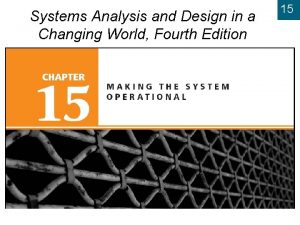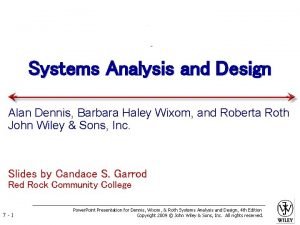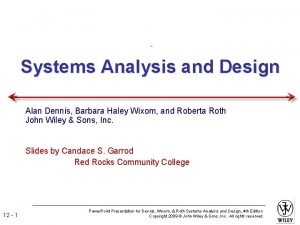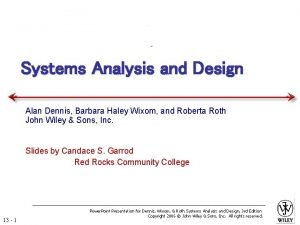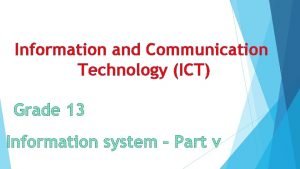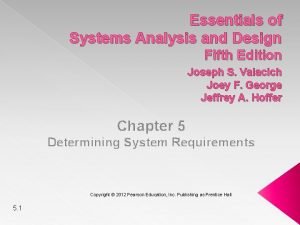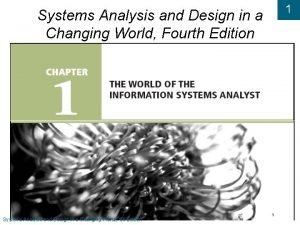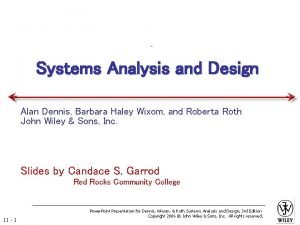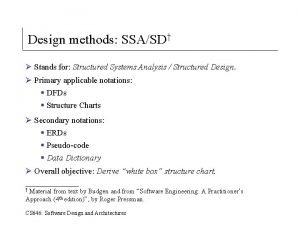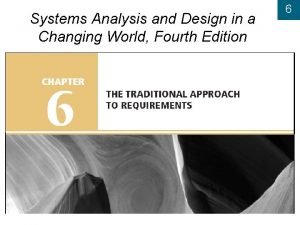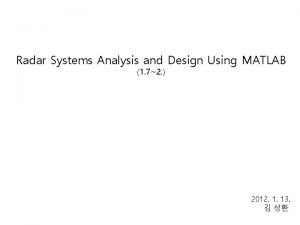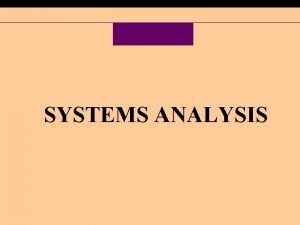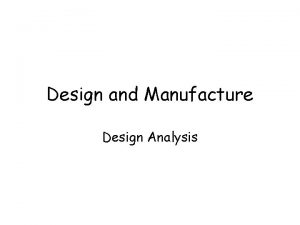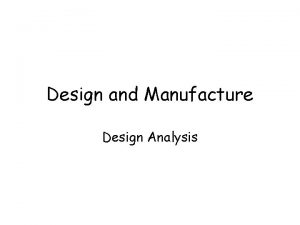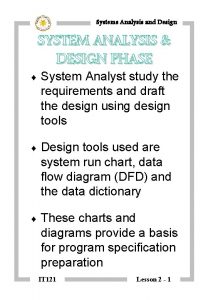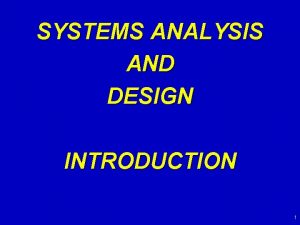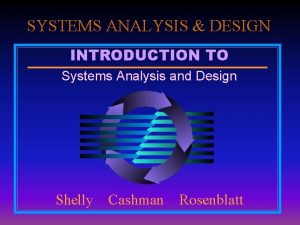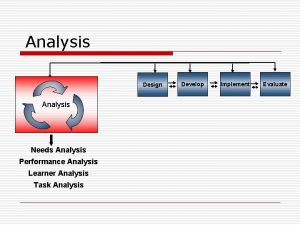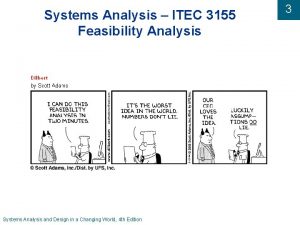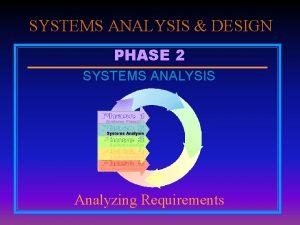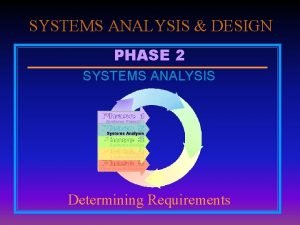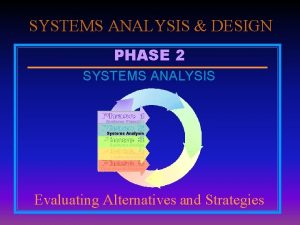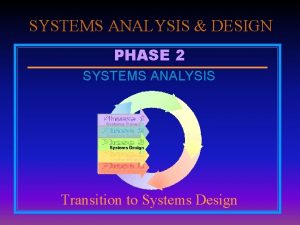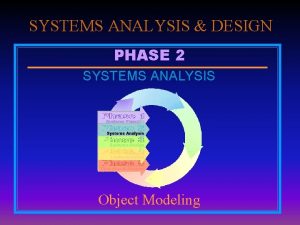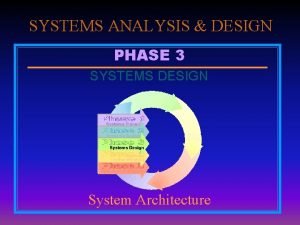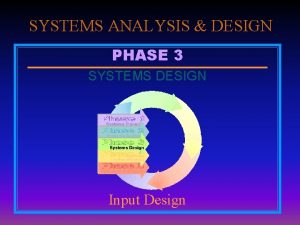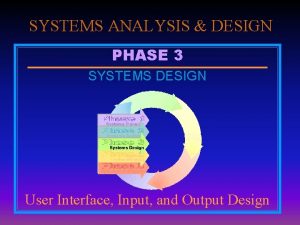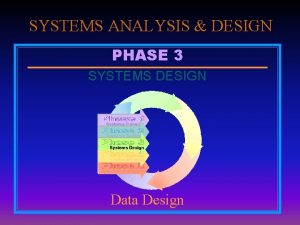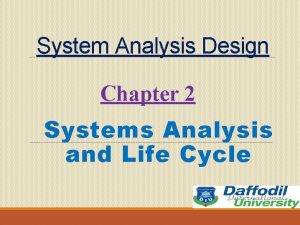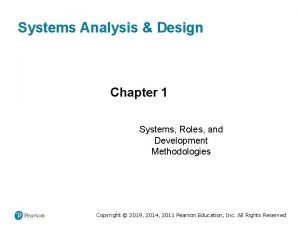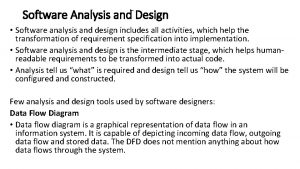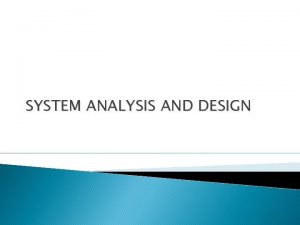Chapter 2 Systems Analysis and Design in a











































- Slides: 43

Chapter 2 Systems Analysis and Design in a Changing World, 7 th Edition - Chapter 2 © 2016. Cengage Learning. All rights reserved. 1

Investigating System Requirements Chapter 2 Systems Analysis and Design in a Changing World 7 th Ed Satzinger, Jackson & Burd Systems Analysis and Design in a Changing World, 7 th Edition - Chapter 2 © 2016. Cengage Learning. All rights reserved. 2

Chapter 2: Outline The RMO Consolidated Sales and Marketing System Project Systems Analysis Activities What Are Requirements? Stakeholders Information-Gathering Techniques Models and Modeling Documenting Workflows with Activity Diagrams Systems Analysis and Design in a Changing World, 7 th Edition - Chapter 2 © 2016. Cengage Learning. All rights reserved. 3

Learning Objectives Describe the activities of systems analysis Explain the difference between functional and nonfunctional requirements Identify and understand different kinds of stakeholders and their contributions to requirements definition Describe information-gathering techniques and determine when each is best applied Describe the role of models in systems analysis Develop UML activity diagrams to model workflows Systems Analysis and Design in a Changing World, 7 th Edition - Chapter 2 © 2016. Cengage Learning. All rights reserved. 4

Overview Chapter 1 introduced the system development lifecycle (SDLC) and demonstrated its use for a small project This chapter expands the SDLC processes to cover a wider range of concepts, tools and techniques Core process 3: Discover and understand the details of the problem or need—is the main focus of systems analysis Systems analysis activities are detailed in this chapter A larger Ridgeline Mountain Outfitters (RMO) project is introduced that will be used throughout the text to illustrate analysis and design Systems Analysis and Design in a Changing World, 7 th Edition - Chapter 2 © 2016. Cengage Learning. All rights reserved. 5

Ridgeline Mountain Outfitters (RMO) RMO has an elaborate set of information systems that support operations and management Customer expectations, modern technological capabilities, and competitive pressures led RMO to believe it is time to upgrade support for sales and marketing A new Consolidated Sales and Marketing System was proposed This is a major project that grew out of the RMO strategic planning process Systems Analysis and Design in a Changing World, 7 th Edition - Chapter 2 © 2016. Cengage Learning. All rights reserved. 6

RMO Information Systems Strategic Plan Technology architecture— the set of computing hardware, network hardware and topology, and system software employed by the organization Application architecture—the information systems that supports the organization (information systems, subsystems, and supporting technology) Systems Analysis and Design in a Changing World, 7 th Edition - Chapter 2 © 2016. Cengage Learning. All rights reserved. 7

RMO Existing Application Architecture Supply Chain Management (SCM) 5 years old; Java/Oracle Tradeshow system will interface with SCM Phone/Mail Order System 12 years old; Visual Studio/MS SQL Reached capacity; minimal integration Retail Store System Older package solution; minimal integration Customer Support System (CSS) Web based system; evolved over the years, minimal integration Systems Analysis and Design in a Changing World, 7 th Edition - Chapter 2 © 2016. Cengage Learning. All rights reserved. 8

Proposed Application Architecture: Integrate SCM and New CSMS Systems Analysis and Design in a Changing World, 7 th Edition - Chapter 2 © 2016. Cengage Learning. All rights reserved. 9

New Consolidated Sales and Marketing System (CSMS) Sales Subsystem Integrates online, phone, and retail stores Order Fulfillment Subsystem Track shipments, rate products and services Customer Account Subsystem Shopping history, linkups, “mountain bucks” rewards Marketing Subsystem Promotional packages, partner relationships, more complete merchandise information and reporting Systems Analysis and Design in a Changing World, 7 th Edition - Chapter 2 © 2016. Cengage Learning. All rights reserved. 10

Systems Analysis Activities (1 of 2) The New Consolidated Sales and Marketing System (CSMS) will require discovering and understanding extensive and complex business processes and business rules The SDLC indicates the project starts with identifying the problem, obtaining approval, and planning the project (as seen in Chapter 1) To get to the heart of systems analysis, this text skips right to analysis activities generally and the specifically for the RMO C SMS project (Core Process #3) Project planning and project management are covered I detail later in the text Systems Analysis and Design in a Changing World, 7 th Edition - Chapter 2 © 2016. Cengage Learning. All rights reserved. 11

Systems Analysis Activities: Involve discovery and understanding Systems Analysis and Design in a Changing World, 7 th Edition - Chapter 2 © 2016. Cengage Learning. All rights reserved. 12

Systems Analysis Activities (2 of 2) Gather Detailed Information Interviews, questionnaires, documents, observing business processes, researching vendors, comments and suggestions Define Requirements Modeling functional requirements and non-functional requirements Prioritize Requirements Essential, important, vs. nice to have Develop User-Interface Dialogs Flow of interaction between user and system Evaluate Requirements with Users User involvement, feedback, adapt to changes Systems Analysis and Design in a Changing World, 7 th Edition - Chapter 2 © 2016. Cengage Learning. All rights reserved. 13

What Are Requirements? System Requirements = Functional requirements Non-functional requirements Functional Requirements– the activities the system must perform Business uses, functions the users carry out Shown as use cases in Chapter 1 Non-Functional Requirements– other system characteristics Constraints and performance goals Systems Analysis and Design in a Changing World, 7 th Edition - Chapter 2 © 2016. Cengage Learning. All rights reserved. 14

FURPS+ Requirements Acronym (1 of 2) Functional requirements Usability requirements Reliability requirements Performance requirements Security requirements + even more categories… Systems Analysis and Design in a Changing World, 7 th Edition - Chapter 2 © 2016. Cengage Learning. All rights reserved. 15

FURPS+ Requirements Acronym (2 of 2) Requirement categories FURPS categories Example requirements Functional Functions Business rules and processes Usability Reliability Performance Security User interface, ease of use Failure rate, recovery methods Response time, throughput Access controls, encryption Nonfunctional Systems Analysis and Design in a Changing World, 7 th Edition - Chapter 2 © 2016. Cengage Learning. All rights reserved. 16

Additional Requirements Categories Design constraints – Specific restrictions for hardware and software Implementation requirements Specific languages, tools, protocols, etc. Interface requirements Interface links to other systems Physical requirements Physical facilities and equipment constraints Supportability requirements Automatic updates and enhancement methods Systems Analysis and Design in a Changing World, 7 th Edition - Chapter 2 © 2016. Cengage Learning. All rights reserved. 17

Stakeholders: Who do you involve and talk to? Stakeholders– persons who have an interest in the successful implementation of the system Internal Stakeholders– persons within the organization External stakeholders – persons outside the organization Operational stakeholders – persons who regularly interact with the system Executive stakeholders– persons who don’t directly interact, but use the information or have financial interest Systems Analysis and Design in a Changing World, 7 th Edition - Chapter 2 © 2016. Cengage Learning. All rights reserved. 18

Stakeholders of a comprehensive accounting system for public company Systems Analysis and Design in a Changing World, 7 th Edition - Chapter 2 © 2016. Cengage Learning. All rights reserved. 19

Stakeholders For RMO CSMS Project Phone/mail sales order clerks Warehouse and shipping personnel Marketing personnel who maintain online catalog information Marketing, sales, accounting, and financial managers Senior executives Customers External shippers (e. g. , UPS and Fed. Ex) Systems Analysis and Design in a Changing World, 7 th Edition - Chapter 2 © 2016. Cengage Learning. All rights reserved. 20

RMO Internal Stakeholders Systems Analysis and Design in a Changing World, 7 th Edition - Chapter 2 © 2016. Cengage Learning. All rights reserved. 21

Information Gathering Techniques Interviewing users and other stakeholders Distributing and collecting questionnaires Reviewing inputs, outputs, and documentation Observing and documenting business procedures Researching vendor solutions Collecting active user comments and suggestions Systems Analysis and Design in a Changing World, 7 th Edition - Chapter 2 © 2016. Cengage Learning. All rights reserved. 22

Interviewing Users and Other Stakeholders Prepare detailed questions Meet with individuals or groups of users Obtain and discuss answers to the questions Document the answers Follow up as needed in future meetings or interviews Systems Analysis and Design in a Changing World, 7 th Edition - Chapter 2 © 2016. Cengage Learning. All rights reserved. 23

Themes for Information Gathering Questions Theme Questions to users What are the business operations and processes? What do you do? How should those operations be performed? How do you do it? What steps do you follow? How could they be done differently? What information is needed to perform those operations? What information do you use? What inputs do you use? What outputs do you produce? Systems Analysis and Design in a Changing World, 7 th Edition - Chapter 2 © 2016. Cengage Learning. All rights reserved. 24

Preparing for the Interview (1 of 2) Before Establish the objective for the interview. Determine correct user(s) to be involved. Determine project team members to participate. Build a list of questions and issues to be discussed. Review related documents and materials. Set the time and location. Inform all participants of objective, time, and locations. During Arrive on time. Look for exception and error conditions. Probe for details. Take thorough notes. Identify and document unanswered items or open questions. Systems Analysis and Design in a Changing World, 7 th Edition - Chapter 2 © 2016. Cengage Learning. All rights reserved. 25

Preparing for the Interview (2 of 2) After Review notes for accuracy, completeness, and understanding. Transfer information to appropriate models and documents. Identify areas needing further clarification. Thank the participants. Follow up on open and unanswered questions. Systems Analysis and Design in a Changing World, 7 th Edition - Chapter 2 © 2016. Cengage Learning. All rights reserved. 26

Interview Session Agenda (1 of 2) Discussion and Interview Agenda Setting Objective of Interview Determine processing rules for sales commission rates Date, Time, and Location April 21, 2016, at 9: 00 a. m. in William Mc. Dougal’s office User Participants (names and titles/positions) William Mc. Dougal, vice president of marketing and sales, and several of his staff Project Team Participants Mary Ellen Green and Jim Williams Systems Analysis and Design in a Changing World, 7 th Edition - Chapter 2 © 2016. Cengage Learning. All rights reserved. 27

Interview Session Agenda (2 of 2) Interview/Discussion 1. Who is eligible for sales commissions? 2. What is the basis for commissions? What rates are paid? 3. How is commission for returns handled? 4. Are there special incentives? Contests? Programs based on time? 5. Is there a variable scale for commissions? Are there quotas? 6. What are the exceptions? Follow-Up Important decisions or answers to questions See attached write-up on commission policies Open items not resolved with assignments for solution See Item numbers 2 and 3 on open items list Date and time of next meeting or follow-up session April 28, 2016, at 9: 00 a. m. Systems Analysis and Design in a Changing World, 7 th Edition - Chapter 2 © 2016. Cengage Learning. All rights reserved. 28

Keeping an Open Items List ID Issue title Date identified Target end date Responsible project person User contact Comments 1 Partial shipments 6 -12 -2016 7 -15 -2016 Jim Williams Jason Nadold Ship partials or wait for full shipment? 2 Returns and commissions 9 -01 -2016 Jim Williams William Mc. Dougal Are commissions recouped on returns? 3 Extra commissions 8 -01 -2016 Mary Ellen Green William Mc. Dougal How to handle commissions on special promotions? 7 -01 -2016 Systems Analysis and Design in a Changing World, 7 th Edition - Chapter 2 © 2016. Cengage Learning. All rights reserved. 29

Distribute and Collect Questionnaires Systems Analysis and Design in a Changing World, 7 th Edition - Chapter 2 © 2016. Cengage Learning. All rights reserved. 30

Review Inputs, Outputs, and Procedures Systems Analysis and Design in a Changing World, 7 th Edition - Chapter 2 © 2016. Cengage Learning. All rights reserved. 31

Additional Techniques Observe and Document Business Processes Watch and learn Document with Activity diagram (next section) Research Vendor Solutions See what others have done for similar situations White papers, vendor literature, competitors Collect Active User Comments and Suggestions Feedback on models and tests Users know it when the see it Systems Analysis and Design in a Changing World, 7 th Edition - Chapter 2 © 2016. Cengage Learning. All rights reserved. 32

Models and Modeling How do we define requirements? After collecting information, create models Model– a representation of some aspect of the system being built Types of Models Textual model– something written down, described Graphical models– diagram, schematic Mathematical models– formulas, statistics, algorithms Unified Modeling Language (UML) Standard graphical modeling symbols/terminology used for information systems Systems Analysis and Design in a Changing World, 7 th Edition - Chapter 2 © 2016. Cengage Learning. All rights reserved. 33

Reasons for Modeling Learning from the modeling process Reducing complexity by abstraction Remembering all the details Communicating with other development team members Communicating with a variety of users and stakeholders Documenting what was done for future maintenance/enhancement Systems Analysis and Design in a Changing World, 7 th Edition - Chapter 2 © 2016. Cengage Learning. All rights reserved. 34

Some Analysis and Design Models Systems Analysis and Design in a Changing World, 7 th Edition - Chapter 2 © 2016. Cengage Learning. All rights reserved. 35

Documenting Workflows with Activity Diagrams Workflow– sequence of processing steps that completely handles one business transaction or customer request Activity Diagram– describes user (or system) activities, the person who does each activity, and the sequential flow of these activities Useful for showing a graphical model of a workflow A UML diagram Systems Analysis and Design in a Changing World, 7 th Edition - Chapter 2 © 2016. Cengage Learning. All rights reserved. 36

Activity Diagrams Symbols Systems Analysis and Design in a Changing World, 7 th Edition - Chapter 2 © 2016. Cengage Learning. All rights reserved. 37

Activity Diagram for RMO Order Fulfillment Systems Analysis and Design in a Changing World, 7 th Edition - Chapter 2 © 2016. Cengage Learning. All rights reserved. 38

Activity Diagram with Concurrent Paths Systems Analysis and Design in a Changing World, 7 th Edition - Chapter 2 © 2016. Cengage Learning. All rights reserved. 39

Summary (1 of 4) Systems analysis activates correspond to the core SDLC process Discover and understand details System projects originate from the information system strategic plan, which contains an technology architecture plan and an application architecture plan The RMO CSMS Project will be used throughout the text as an example of analysis and design Systems Analysis and Design in a Changing World, 7 th Edition - Chapter 2 © 2016. Cengage Learning. All rights reserved. 40

Summary (2 of 4) Systems analysis involves defining system requirements– functional and non-functional Analysis activities include Gather detailed information Define requirements Prioritize requirements Develop user-interface dialogs Evaluate requirements with users FURPS+ is the acronym for functional, usability, reliability, performance, and security requirements Systems Analysis and Design in a Changing World, 7 th Edition - Chapter 2 © 2016. Cengage Learning. All rights reserved. 41

Summary (3 of 4) Stakeholders are the people who have an interest in the success of the project There are internal vs. external stakeholders and operational vs. executive stakeholders Systems Analysis and Design in a Changing World, 7 th Edition - Chapter 2 © 2016. Cengage Learning. All rights reserved. 42

Summary (4 of 4) Information gathering techniques are used to collect information about the project Interviews, questionnaires, reviewing documents, observing business processes, researching vendors, comments and suggestions The UML Activity Diagram is used to document (model) workflows after collecting information Models and modeling are used to explore and document requirements Unified Modeling Language (UML) is the standard set of notations and terminology for information systems models Systems Analysis and Design in a Changing World, 7 th Edition - Chapter 2 © 2016. Cengage Learning. All rights reserved. 43
 Kendall and kendall
Kendall and kendall Systems analysis & design in an age of options
Systems analysis & design in an age of options System analysis and design
System analysis and design Systems analysis and design in a changing world
Systems analysis and design in a changing world System analysis and design in a changing world
System analysis and design in a changing world System analysis and design alan dennis
System analysis and design alan dennis Introduction of system analysis and design
Introduction of system analysis and design Ssadm
Ssadm Systems analysis and design 5th edition
Systems analysis and design 5th edition Modern systems analysis and design
Modern systems analysis and design Kendall and kendall system analysis and design
Kendall and kendall system analysis and design Systems analysis and design alan dennis
Systems analysis and design alan dennis Systems analysis and design alan dennis
Systems analysis and design alan dennis Systems analysis and design alan dennis
Systems analysis and design alan dennis Systems analysis and design alan dennis
Systems analysis and design alan dennis Systems analysis and design alan dennis
Systems analysis and design alan dennis Systems analysis and design alan dennis
Systems analysis and design alan dennis Systems analysis and design alan dennis
Systems analysis and design alan dennis Ssadm diagram
Ssadm diagram Radar systems analysis and design using matlab
Radar systems analysis and design using matlab Object-oriented systems analysis and design using uml
Object-oriented systems analysis and design using uml A modern approach to systems analysis and design
A modern approach to systems analysis and design System analysis and design kendall
System analysis and design kendall System analysis and design in a changing world
System analysis and design in a changing world Systems analysis and design in a changing world
Systems analysis and design in a changing world Systems analysis and design in a changing world
Systems analysis and design in a changing world Systems analysis and design alan dennis
Systems analysis and design alan dennis Systems analysis and design alan dennis
Systems analysis and design alan dennis Systems analysis and design alan dennis
Systems analysis and design alan dennis Modern systems analysis and design 7th edition
Modern systems analysis and design 7th edition Ssadm
Ssadm Essentials of systems analysis and design
Essentials of systems analysis and design Systems analysis and design in a changing world
Systems analysis and design in a changing world Systems analysis and design alan dennis
Systems analysis and design alan dennis List the five basic steps of ssa/sd process
List the five basic steps of ssa/sd process Event table system analysis design
Event table system analysis design Systems analysis and design in a changing world
Systems analysis and design in a changing world Radar system analysis and design using matlab
Radar system analysis and design using matlab Kendall and kendall system analysis and design
Kendall and kendall system analysis and design Input design in system analysis and design
Input design in system analysis and design User interface design in system analysis and design
User interface design in system analysis and design Dialogue design
Dialogue design What is structured analysis?
What is structured analysis? Types of fact gathering in system analysis and design
Types of fact gathering in system analysis and design























